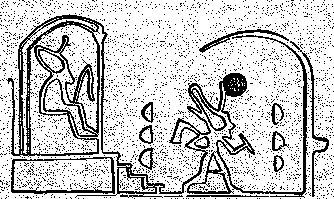4. Easter Island is beginning with 3 islets and ending with 3 mountain tops, with the main land in between. This fact ought to remind us of the 8th glyph (Eb6-1) in the 24th and last of the henua periods of the Keiti text:
Counted from Eb1-1 it is glyph number 185, and counted from Ea1-1 it is number 511. A text line of 'fire' (rima, 5) has just ended and a new line is beginning. A break in Sun time is evidently illustrated by hetuu with 2 separate Sun discs in Eb5-35. The planetary pattern of the week has obviously been followed, with Sun not only in Eb6-19 but also as glyph number 26 in the period. But it is Mercury (presumably the first of the pair of birth places of Moon) which determines where the weeks are beginning, not Sun, i.e. we should be at the back side of the cycle. In Eb6-2 the ihe tau sign is followed by a hanging down maro, which should mean Eb6-2 indicates the opposite to death ('end of death'), cfr also the reversed ihe tau in Eb6-9. A new cycle is about to begin. In between 3 'islets' and 3 'mountain tops' in Eb6-1 there is a vacuum, nothing visible, an interregnum. What is remarkable is the resemblance (which we have seen earlier) with an ancient Egyptian picture illustrating the pivotal point of the Sed festival (probably held with intervals of 30 years):
Even if there weres some features (of which I am unaware) in the landscape of ancient Egypt which resembled the 3 islets and the 3 mountain tops on Easter Island it would still be strange to find this resemblance in pictorial form and meaning. The only reasonable explanation I can imagine is to search in the night sky for a structure with 3 + 0 + 3 stars. If we can find such a structure, then it would not be strange to find it depicted both in ancient Egypt and on Easter Island. And indeed it would be strange if it was not depicted also in other places. |










